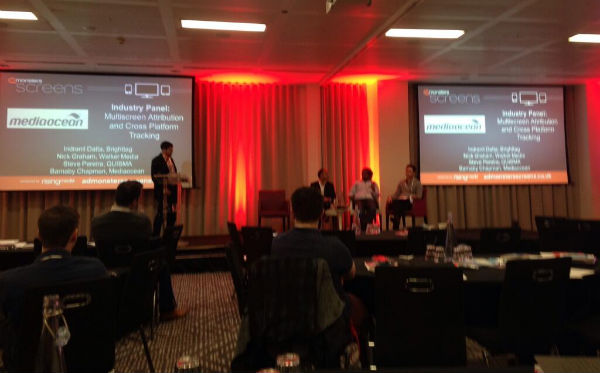
Image from a sponsored Industry Panel session at this year’s London Screens.
Last week I chaired my last AdMonsters conference for now. It was the conference looking at the second screen, omni-screen attribution, and the multi-channel aspect of advertising.
Luckily, I had a second moderator too, so the day was a little less stressful compared to previous conferences. Below you find my key take aways from the day:
Twitter had a presentation, and I am often wondering how they will make money, particularly that they are now a public-limited company. But they started to connect TV and social, the public conversation, through a little hashtag. The conversations around a product, a TV show or a topic can be scaled and brands or advertisers can engage and get communicating. Actually, this is a great way of utilising the second screen to TV, the mobile, from which 82% of all tweets are sent.
Often, I wonder what we did in the time before Twitter. I suppose it gives the shy people an opportunity to engage, the loud people the opportunitiy to write rather than to shout, and of course it gives brands a way of communicating with their fan bases. It gives me a way of ranting about commuting with Southern Railway. This wasn’t there before – this is incremental reach and engagement. Soon, Twitter will allow synced advertising to the TV streamed advertising. Also, Vine, its video micro-chatter programme, gives it another channel too. I believe there will be more exciting things ahead.
Nielsen’s presentation was aiming to give us a good understanding of cross-device measurement, which is what’s been done so far. It tells us that, actually, you cannot really measure people; but, you should measure people, and you shouldn’t trust the 3rd-party cookie. So measuring people is becoming more important, i.e,. people NOT cookies, collecting data, encoding data, and making use of big data. Yet, we all know that big data only answers the ‘what’ question, not the ‘why’. So we measure the person after all, but we cannot measure unduplicated reach across devices and also the sample sizes Nielsen showed seemed a bit vague. I believe they got the infrastructure, the idea and experience but is there enough scale in Europe. Hopefully we hear more exciting stuff soon!
The whole debate about the preferred screen, or as Jon from ITV put it in a later discussion, “the biggest preferred screen after TV is your second screen”, started with his X Factor case study. He made a good point that from a broadcaster perspective, the mobile or tablet would always be a second screen, yet TV learned from those devices to link them up and engage with their audience in real time. His case for Dominos Pizza was clear, close to 750,000 pizzas were thrown into boxes in an online game on the X Factor application whilst people were supposed to be watching the show. Engagement in apps, questions and answers, games and prize wins, are crucial for a good engagement. I enjoyed this session and it made a lot of sense.
Whilst, of course those campaigns achieve a high CTR, brand awareness and engagement, the idea as such is not new. However, the challenge to deliver it, make it more engaging and proving the ROI is getting harder. The technology to link the “live advertising on TV” to “in-app or mobile/desktop web advertising” will be a future proof thing. Adobe and M6 showed that clearly during their ‘fireside chat’ too.
And again, in the ongoing discussions on the second screen panel, the attribution panel, and the transcendent screen panel…the overall view was the same. Mobile is the preferred device for most things. Then if anything important needs to be done, we choose a laptop/desktop, whilst the tablet is more of an entertainment device. With price points dropping and Tesco and Argos both making tablets available for the masses, it will be the first screen for anyone accessing the Web soon. Mobiles and tablets are dominating the online access, being used whilst TV is on in the background. Some would differentiate on the emotional attachment to each device too.
Of course, TV is still being watched, maybe even more intensely by connecting the devices – the advertising and engaging through apps rather than the “red button”. But online and offline are merging too: Blippar showed us an amazing case study about AR (Augmented Reality). Quisma nicely pointed out, as stated before, that only a few companies have logged in accounts across all screens: Amazon, Twitter, Yahoo!, Apple, Microsoft and Google. They will be able to track you. AdTruth, Drawbridge and others try to crack attribution and identification without cookies yet still haven’t quite got to where the big guys are. Or have they?
Now my last question to the audience would be: do we actually want to be targeted across all devices or is it uncool to see the same ad on your mobile whilst seeing it on TV. Would complementary ads be better? How does the re-targeting piece fit in?
There are still a lot of unanswered questions. As I am hoping to continue to contribute to the AdMonsters programmes in the future, I am looking forward to continuing the conversation.
We see you at the next AdMonsters hopefully.